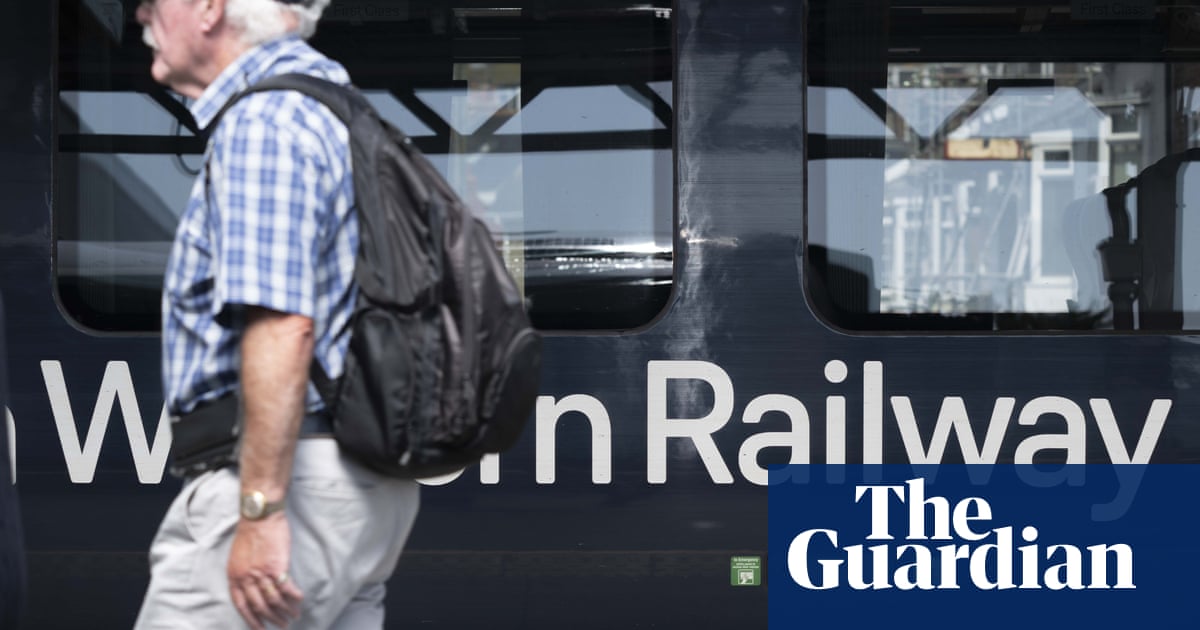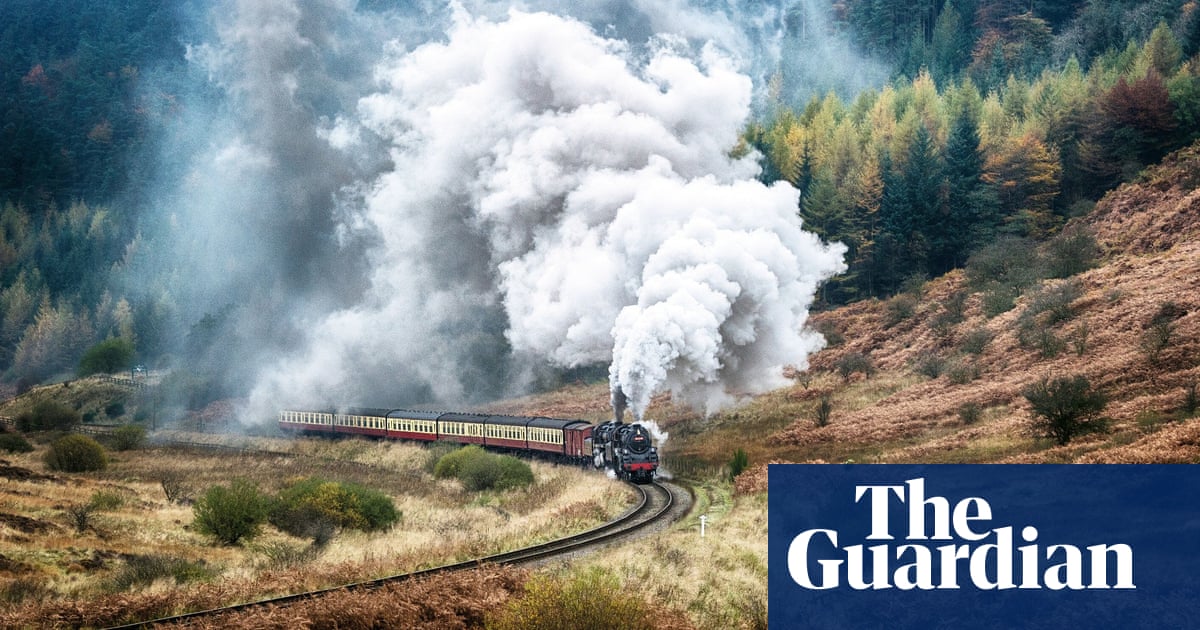
In 2017, the “commuter train of the future” boasted an onboard gym, games consoles, swivelling armchairs and private pods for making calls or using laptops. It was, according to the Sun, “so awesome it could actually make you want to go to work”.
Unfortunately it did not quite exist: the Deutsche Bahn design team’s concept train, the Ideenzug (Ideas Train), unveiled six years ago, was trying to counter what was then perceived as the biggest threat to their market: self-driving cars, whose users, they said, would soon be able to relax on the way to work.
A few pandemic-ravaged years later, the challenge is infinitely harder: post-Covid, many former reluctant commuters do not need to travel to work at all.
Working from home is firmly embedded for a significant minority – particularly those rail passengers who used to cram the London-bound platforms of the south-east and home counties.
Leisure travel is booming – higher than before Covid on some routes – but the railway’s bread and butter, the commuters and season-ticket holders, and the prized custom of business travellers, are yet to return. Revenue from fares grew to £2.2bn in the first quarter of this year but is still lagging behind the pre-pandemic benchmark – 2019’s £12bn income – by about 30% once inflation is factored in, according to industry calculations.
There has always been a subsidy to balance rail’s books, but the ongoing state input – even if now projected to be much nearer the £5bn of 2019 than the £17.6bn spent in the first year of the pandemic – is seen as unsustainable. Cuts have been demanded, and wages stifled – bringing about the toxic impasse between employers and unions, with strikes and enduringly disruptive overtime bans.
Speaking at the start of 2023, the transport secretary, Mark Harper, had quickly identified the “desire to end the sense of drift” and turn around rail. What is the industry doing to turn things round and shake off the gloom?
Reforming fares
A focus on single-leg tickets, rather than returns, and abolishing Friday peak fares on long-distance trains, has reflected changing travel patterns, as well as flexible season tickets for part-time use. These new fares have been promoted heavily, along with reward schemes by the commuter-belt networks like South Western, to lure people back. The next step is a trial of airline-style demand-based pricing, due on LNER later this year.
But over the past decade fares have risen significantly beyond consumer inflation, and while full-time season tickets made the daily cost more reasonable, peak-time travel – often twice the price of an off-peak fare – is now a prohibitive consideration for many.
On Wednesday the traditional benchmark for annual fare increases, July’s retail prices index (RPI) figure, is out again – and while the government expects for a second year to rein in rises well below RPI, another steep rise looks likely.
According to the Department for Transport, no decision has yet been made but a spokesperson said it would “ensure we strike a balance between supporting passengers and keeping our railways running”.
Sorting out the strikes
After signs of more pragmatic dialogue and a settlement with Network Rail signallers at the start of the year, optimism has faded. The lower-level ongoing disruption is failing to move ministers – even if such unpredictability is the last thing an industry in search of customer revenue needs.
As Anthony Smith, the chief executive of the passenger watchdog, Transport Focus, puts it, wider plans to lure people back can only succeed “when you’ve got a stable product – once the industry has stabilised and offers that key cornerstone, reliability, of what passengers want”.
The resolution of wider public sector disputes could make a slightly more generous offer politically feasible, especially if that ends up wrapped into a 2024 deal when inflation may also have fallen – and if a U-turn on ticket offices and compromises on “modernisation” allow the unions to claim some wins too.
Heading for net zero
With the Treasury paying the bills, the industry has trod a fine line in political critique – but even the Rail Delivery Group (which represents train companies) has occasionally publicly raised an eyebrow at cuts in fuel duty for motorists and airline passenger duty while train fares continue to rise.
Calculations the RDG recently commissioned suggest some rail journeys’ carbon footprint may be lighter than previously assumed – underlining that trains, especially if integrated with buses, remain key should the UK seriously attempt to catch up with its climate targets. The railway should continue to shout about its crucial role and push for more electrification of tracks, an ambition which has been allowed to falter.
Putting the passenger first
This recurrent theme of rail leaders’ public proclamations – Harper said GBR must be “wholeheartedly customer-focused” – looks increasingly forlorn in the new financial winter.
Instead, the government has pushed operators to announce wholesale ticket office closures, sparking a backlash from all quarters including the former head of the DfT’s train operating unit, Sir Michael Holden. He declared that the move confirmed that “at the top of our government there is no longer any interest in the future of rail, just to cut its cost as soon as possible”.
The public consultation has already been extended, with more than 300,000 people responding to the proposals. The RDG says staff can be more productive and available to customers on the platform, but savings ultimately depend on fewer salaries and will lead, the RMT’s Mick Lynch argues, to a “dehumanised railway”. As rail historian Christian Wolmar notes, through 25 years of privatisation, “train companies who paid for the offices, who could have closed them, hadn’t done so”.
Investing for growth
Orders from the DfT to run down wifi to cut costs are similarly concerning, Smith says. “People just expect it. If it is something that makes it easier to choose rail, it seems it should be prioritised. Rail has got see that its market has become discretionary. In the future you have to think, how can we make this as attractive as possible?”
Onboard entertainment such as the Beam system on Virgin Trains in the latter days of franchising may have been superseded – but it’s not just the technology that has changed.
Current contracts and the funding model means any expenditure needs to be approved by the DfT. That hampers any ambitions from operators to drum up custom – and growing revenue is the only way to escape the current malaise, says Roger Ford, industry editor at Modern Railway.
“The government says the funding is unsustainable, but they don’t say what is sustainable,” Ford says. “You can’t get more sustainable by cutting costs – the costs you can cut are minimal. The only way is to go for growth.”
Overhauling the structure
Plans to create Great British Railways, or a similar body with a less boosterish name, are still officially on track: an independent body to fix timetables and award contracts, align the aims of train and track operators, and minimise central micromanaging.
But with legislation only coming “as soon as parliamentary time allows”, according to the Department for Transport, many industry observers have written off GBR for now – at least until Labour or whoever forms the next government commits.
One of the jobs being undertaken by GBR transition staff in limbo is “working to simplify the huge range of ticketing options”, according to a spokesperson, and extending pay-as-you-go with more tap-in and out stations coming this year in the south-east and beyond.
Advance fares you can swap
Passengers are often told to buy in advance for better value – but that can prove an expensive waste if timings change and a whole new ticket is needed. Northern, LNER and CrossCountry have now partnered with Seatfrog to allow people to swap their train for a fee, making advance tickets less of a gamble on life going to plan.
Smarter reservations and information
The anxious search for a seat on busy long-distance trains has been eased by a number of companies. For example, on Avanti’s upgraded Pendolinos, onboard monitoring systems detect when a reserved seat is unclaimed; CrossCountry allows reservations by text up to 10 minutes before; and LNER will message with reminders of your seat and on which platform to find your train.
Trains running on vegetable oil
In the absence of electrification, Chiltern has taken a step to reduce its carbon footprint and emissions on routes otherwise dependent on diesel. A number of locomotives have been converted to run on recycled hydrotreated vegetable oil (HVO), which Chiltern says cuts nitrogen oxides emissions by 85% compared with diesel.
Level boarding
The kind of unglamorous and unheralded development that is crucial for many travellers with disabilities – and welcome for anyone struggling with a pram or heavy cases. It was rolled out first by Merseyrail and Greater Anglia, and now parts of the southern Transport for Wales network have the Stadler-made trains whose carriage floors sit level with the standard platform.
Folk trains return
Other people’s music on trains can be annoying, but for those who appreciate it or want to join in, carriages on services to the Lakes and Peak District have occasionally been devoted to live instrumentalists. With the tacit blessing of Northern, some of the folk trains stopped by Covid have now restarted from Manchester Piccadilly.
Germany’s Ideenzug
In Germany, the 2017 concept “Ideas Train” finally entered passenger service last month – minus the gym and consoles. But on one double-decker carriage on the Munich-Mühldorf route, there are office pods with built-in monitors, those armchairs, and seating for families or regulars to chat.












